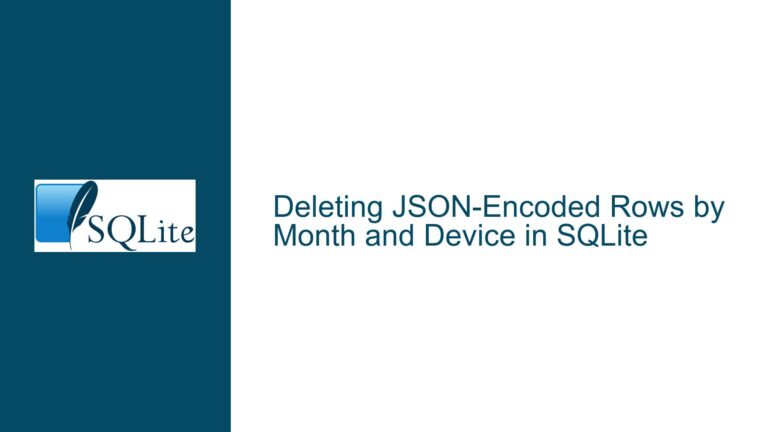Implementing “Get or Create” Functionality in SQLite with INSERT OR IGNORE and RETURNING
SQLite INSERT OR IGNORE with RETURNING Clause Behavior
The core issue revolves around implementing a "get or create" pattern in SQLite, where a single SQL statement is desired to either retrieve an existing row or insert a new one and return the rowid in both scenarios. The challenge arises from the behavior of the INSERT OR IGNORE statement combined with the RETURNING clause. Specifically, when using INSERT OR IGNORE, the RETURNING clause only returns a value if a new row is inserted. If the row already exists and the insert is ignored, no row is returned, which complicates the implementation of a "get or create" pattern in a single query.
The INSERT OR IGNORE statement is designed to insert a new row only if it does not violate any unique constraints. If a unique constraint is violated, the insert operation is silently ignored. The RETURNING clause, introduced in SQLite 3.35.0, allows the query to return the values of the newly inserted row. However, when INSERT OR IGNORE is used, the RETURNING clause only produces output if a new row is actually inserted. This behavior is by design, as the IGNORE modifier suppresses errors and, consequently, any output when the insert operation is skipped.
To achieve the desired "get or create" functionality, one must understand the interplay between unique constraints, the INSERT OR IGNORE statement, and the RETURNING clause. The absence of a primary key or unique constraint in the original table definition means that every INSERT operation will always insert a new row, making the IGNORE modifier irrelevant. However, when a unique constraint is added, the INSERT OR IGNORE statement becomes meaningful, but the RETURNING clause’s behavior becomes a limitation.
Unique Constraints and the Role of INSERT OR REPLACE
The behavior of the INSERT OR IGNORE statement is closely tied to the presence of unique constraints in the table schema. Without a unique constraint, every INSERT operation will result in a new row being added, and the IGNORE modifier has no effect. However, when a unique constraint is present, the INSERT OR IGNORE statement will only insert a new row if it does not violate the unique constraint. If the constraint is violated, the insert operation is ignored, and no row is returned by the RETURNING clause.
An alternative to INSERT OR IGNORE is the INSERT OR REPLACE statement, which replaces the existing row if a unique constraint violation occurs. This statement ensures that a row is always returned by the RETURNING clause, as either a new row is inserted or an existing one is replaced. However, INSERT OR REPLACE may not be suitable for all use cases, as it replaces the entire row, potentially losing data in the process.
To implement a "get or create" pattern, one must carefully consider the table schema and the specific requirements of the application. If the goal is to ensure that a row is always returned, regardless of whether it was newly inserted or already existed, a combination of INSERT OR IGNORE and a subsequent SELECT statement may be necessary. This approach ensures that the rowid of the existing or newly inserted row is always available, even if the RETURNING clause does not provide it directly.
Combining INSERT OR IGNORE with SELECT for "Get or Create"
To achieve the "get or create" functionality in SQLite, a two-step approach is often required. The first step involves attempting to insert a new row using INSERT OR IGNORE with the RETURNING clause. If the insert operation is successful, the RETURNING clause will provide the rowid of the newly inserted row. If the insert operation is ignored due to a unique constraint violation, the RETURNING clause will not return any rows.
The second step involves querying the table to retrieve the rowid of the existing row that caused the unique constraint violation. This can be done using a SELECT statement with a WHERE clause that matches the unique constraint. By combining these two steps, the application can ensure that it always has access to the rowid of the desired row, whether it was newly inserted or already existed.
Here is an example of how this can be implemented in SQLite:
-- Step 1: Attempt to insert a new row
INSERT OR IGNORE INTO table1 (a, b) VALUES ('a', 1) RETURNING rowid;
-- Step 2: If no row was returned, query the existing row
SELECT rowid FROM table1 WHERE a = 'a' AND b = 1;
In this example, the first statement attempts to insert a new row into table1 with the values ('a', 1). If the insert operation is successful, the RETURNING clause will return the rowid of the newly inserted row. If the insert operation is ignored due to a unique constraint violation, the RETURNING clause will not return any rows, and the application must execute the second statement to retrieve the rowid of the existing row.
This two-step approach ensures that the application always has access to the rowid of the desired row, whether it was newly inserted or already existed. While this approach requires two separate SQL statements, it provides a reliable way to implement the "get or create" pattern in SQLite.
Optimizing the "Get or Create" Pattern with Transactions
To ensure atomicity and consistency when implementing the "get or create" pattern, it is advisable to wrap the two-step approach in a transaction. This prevents race conditions where another thread or process might modify the table between the INSERT OR IGNORE and SELECT statements. By using a transaction, the application can ensure that the entire operation is executed as a single atomic unit, maintaining the integrity of the data.
Here is an example of how to use a transaction to implement the "get or create" pattern:
BEGIN TRANSACTION;
-- Step 1: Attempt to insert a new row
INSERT OR IGNORE INTO table1 (a, b) VALUES ('a', 1) RETURNING rowid;
-- Step 2: If no row was returned, query the existing row
SELECT rowid FROM table1 WHERE a = 'a' AND b = 1;
COMMIT;
In this example, the BEGIN TRANSACTION statement starts a new transaction, and the COMMIT statement commits the transaction, making the changes permanent. If any error occurs during the transaction, the application can use the ROLLBACK statement to undo the changes and maintain data consistency.
Using transactions ensures that the "get or create" operation is executed atomically, preventing race conditions and ensuring that the application always has access to the correct rowid. This approach is particularly important in multi-threaded or multi-process environments where concurrent access to the database is possible.
Conclusion: Balancing Efficiency and Reliability in SQLite
Implementing a "get or create" pattern in SQLite requires a careful balance between efficiency and reliability. While it would be ideal to achieve this functionality with a single SQL statement, the current behavior of the INSERT OR IGNORE and RETURNING clauses makes this challenging. By combining INSERT OR IGNORE with a subsequent SELECT statement and wrapping the operation in a transaction, applications can reliably implement the "get or create" pattern while maintaining data integrity.
This approach, while requiring two separate SQL statements, provides a robust solution that works within the constraints of SQLite’s current capabilities. As SQLite continues to evolve, future versions may introduce new features or enhancements that simplify the implementation of such patterns. Until then, the two-step approach outlined here offers a reliable and efficient way to achieve the desired functionality.






